Your Planets
Portraits of the Planets
Aspects between Planets
The planetary ages
The planetary families
Planets in Signs
The Planets in comics


You will find few books on the history of astrology. They are rare. So much so that if you have one of them in your library, it could disappear by magic. Astrologers-astronomers, before the XVIIth century, used the rational of their science to apply it to the irrational of their art, have half disappeared from our dictionaries. We only see the astrometric emergence. Where have the astrologers gone? It takes a bit of perversity to find their ashes under new biographical definitions. Almost all of them, under the feathers of exorcists, have become “philosophers”… Our children and adolescents are tenderly defended against bad reading. Will they ever know — unless they are led astray — that Jérôme Cardan (1501–1576), “philosopher, physician and mathematician” according to Universal Dictionary of Proper Names, inventor of the joint device that bears his name (the gimbal) was an astrologer? Clearly, the mechanism should not work… No more than the ideas, discoveries, tests, other “philosophers” à la Cardan, should not hold the road…
We will never have drunk as much, they say, as under prohibition. Our exorcists, far from suppressing the forbidden demons of philosophy, have provoked a flood of astrologies in all directions, all tendencies. Cardan has made small… It seems late to stop the wave, to reify the dikes of reason against this excess of philosophy. Height of threats to the future of our barriers, their builders have not changed their methods.
Their inefficiency demonstrated by the proliferation of astrology associations and schools has still not convinced the censors that it was better to open the debate publicly: to really inform about astrology, its history, its men, its different conceptions, instead of retaining the dunces, the failures, the easily refuted aberrations ; recall what modern astronomy owes to precursors astronomers-astrologers rather than dishonor themselves by lending them last-minute adjurations; say, before the ephemeral century of the Enlightenment arrives, how much astrologers and astrology, neither more nor less fatal than other beliefs (the lesser) were present, rather than shamefully purge history or write it under the banner of one-sided dialectics. Finally, talk about the zodiac of the Signs and the constellations without skipping the point of view and the practice of astrologers.
What we are going to do. The subject of this book being the twelve Signs, it is as well to recall what they are in relation to the groups of stars which bear the same names, what makes their difference and what phenomenon has separated them in the minds of men…
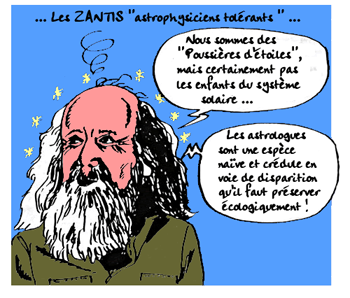 Among the many articles of amusing sociology that the major press devotes to astrology during vacation periods and public holidays, in December 85 The Express still wondered whether to believe it… In return for an article focused on symbolizing astrologies, the astrophysicist Hubert Reeves, without being a witch hunter, let himself be told: “I am not convinced that there is a real relationship between astrology and the stars. For example, being born on July 13, astrologers tell me that I am Cancer. Which should imply that the Sun, when I was born, was in the constellation Cancer. This was true two thousand years ago. It is no longer today. When I was born, the Sun was in Gemini. It bothers me, although I have been given ‘explanations’.”
Among the many articles of amusing sociology that the major press devotes to astrology during vacation periods and public holidays, in December 85 The Express still wondered whether to believe it… In return for an article focused on symbolizing astrologies, the astrophysicist Hubert Reeves, without being a witch hunter, let himself be told: “I am not convinced that there is a real relationship between astrology and the stars. For example, being born on July 13, astrologers tell me that I am Cancer. Which should imply that the Sun, when I was born, was in the constellation Cancer. This was true two thousand years ago. It is no longer today. When I was born, the Sun was in Gemini. It bothers me, although I have been given ‘explanations’.”
Let’s skip over the embarrassment of explanations, rather singular when you know all that scientists allow themselves in terms of working hypotheses… and of all rest! Let us only observe the elimination of the word “Sign”. Hubert Reeves wants to be born at the passage of the Sun in a constellation (that of Gemini) but not in a sign (Cancer). However, the astrologers spoke to him of the Sign and not of the constellation. Word “Sign” would it never have existed in astrometry or after the mutation from astrologer to philosopher, are we witnessing a new mutation in applied terminology? Would there then be unknown genes in the words of use? It should be specified that the death of the Sign, unpleasant to the poet, would arrange the scientistic species in a dominant phase. Just as there would never have been an astronomer-astrologer since, without knowing it, they were philosophers, there has never been a constellation-Sign… since, without knowing it, the Signs were stars. Why talk about Signs and differences?
This pretty Jarnac shot brought to the vocabulary as well as to the cultural heritage is quite recent. It is not certain that the maneuver will generalize, new words have the fragility of cherubim and incredible but vain words. Thus, the venerable Job Calendar always indicates, in 85 and 86, the dates and times (in universal time) of entry of the Sun into the Signs of the zodiac, while the Astronomical calendar abstains from these heretical indications. What chimeras must one feed one’s resentment to believe in the power of words against facts? In 1968, the Bureau des longitudes directory still indicated, as the Job Calendar, the dates and times of entry of the Sun into the Signs, as well as of the planets… Since then, it is to be feared, the Directory has undoubtedly aligned itself with the little red book of anti-astrology insidious.
By modifying the definitions, the new astrometers verbally eliminate the contradictions that bothered their elders, but neither the history nor the data of the problem have changed. The precession of the equinoxes is still there.
Let’s see the terms. Precession first. When Pierre walks in front of Paul and Paul in front of Jacques, Pierre precedes Paul and Jacques, Paul precedes Jacques. Heard. As before, the Latin origin of precession is preceded, “walk ahead”. On this point, when it comes to physical phenomena and not people, our dictionaries do not introduce their fantasies.
Let’s go to the equinoxes. The term is made up of the Latin aequus, “equal”, and nox, “night”. All this being difficult to contest, we deduce, in agreement with the Little Larousse, that the equinox marks the time of year “…where the Sun, in its own apparent motion on the ecliptic, intersects the celestial equator”, which leads, in absolute terms and not in reality (there are always differences between the two), to the equality of days and nights (12 hours in each camp, draw).
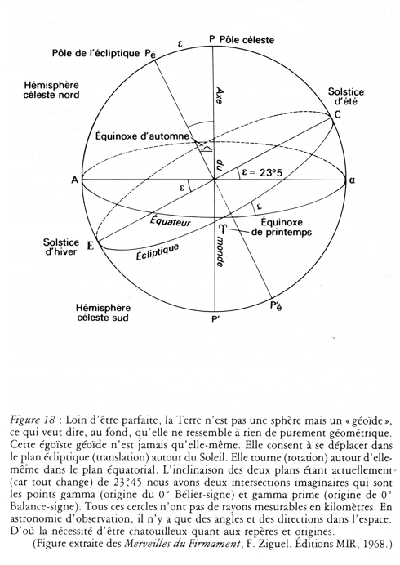 The point on the celestial equator where this transition occurs is designated by “vernal point” or “gamma point” which is defined by the intersection of the ecliptic and equator planes. When the center of the solar disk coincides with the vernal point (of worm, “spring”), in universal time, it is officially 0 hours 0 minutes 0 seconds in the life of the Northern Hemisphere spring, which in no way decides what the season will be in hot and cold, unless you do his horoscope… which is part of traditional astrological practices.
The point on the celestial equator where this transition occurs is designated by “vernal point” or “gamma point” which is defined by the intersection of the ecliptic and equator planes. When the center of the solar disk coincides with the vernal point (of worm, “spring”), in universal time, it is officially 0 hours 0 minutes 0 seconds in the life of the Northern Hemisphere spring, which in no way decides what the season will be in hot and cold, unless you do his horoscope… which is part of traditional astrological practices.
The vernal point also determines the zero degree of the Sign of Aries, the first Sign of the zodiac. If you need to visualize these definitions, refer to Figure 1. You will find, at the two intersections of the celestial equator and the ecliptic:
▶ 1°) The vernal point (or gamma point), spring equinox, origin 0° of Aries and the Signs which follow it.
▶ 2°) Its vis-à-vis, at 180° (or gamma prime), autumnal equinox, origin 0° of the Sign of Libra.
By joining the two points gamma, we get the axis of the equinoxes. The Earth occupies its center, but it only has reality on paper. In its apparent movement, the Sun moves on the ecliptic from west to east, i.e. counterclockwise and in the direction of the apparent daily movement. Its annual walk leads it to renew the spring on the following turn… A turn that will not be exactly 360° since the vernal point has gone to meet it at the insensitive speed of 50.25″ of arc per year (1° in 72 years, 30° in 2,147 years, 360° in 25,760 years which are often rounded up to 26,000). 50.25″ of arc, it’s not nothing, almost. This is enough for the timing of the equinox to advance each year by 20 minutes from the previous year, hence this explicit term precession… coming before. It implies that the Sun in the spring of Year II does not occupy, among the stars, the same position as in the spring of Year I, and that it appears over the centuries “walking through the zodiacal constellations, those that contain the ecliptic. Thus, in the time of Hipparchus, 130 years BC, the Sun appeared at the vernal equinox in Aries, while today it coincides with the constellation of Pisces.”
If we talk about the advance of the vernal point towards the Sun, it is precession. If we speak of its retreat from a stellar landmark, we formulate the same phenomenon in terms of retrogradation of the vernal point.
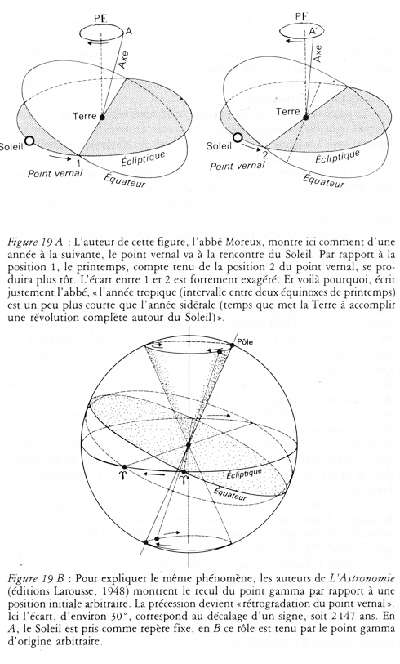 When the Sun returns to the vernal point, the durations of day and night remain equal as during the previous spring millennia… This equality no longer occurs under the sponsorship of the same stars. If you have trouble understanding, Hubert Reeves, who is an excellent popularizer when it is not about astrology, will explain to you what a “repository”. On the other hand, if you understood, explain to him.
When the Sun returns to the vernal point, the durations of day and night remain equal as during the previous spring millennia… This equality no longer occurs under the sponsorship of the same stars. If you have trouble understanding, Hubert Reeves, who is an excellent popularizer when it is not about astrology, will explain to you what a “repository”. On the other hand, if you understood, explain to him.
Since we have two benchmarks for measuring time — the return to the vernal (moving) point and the return to the same point relative to the stars — we have at least two years (there are others):
▶ the tropical year is the time interval between two passages of the Sun through the vernal point or from one spring to another. Its average duration is expressed in average days by 365.24219879, i.e.: 365 d 5 h 48 m 46 s.;
▶ the sidereal year is the time it takes the Sun to come to occupy the same point (from one year to another) with respect to the stars and its duration is expressed in average days per 365.26336042 days, i.e. 365 d 6 h 9 m 10 s.
In other words, the tropical year corresponds to the time taken by the Sun for its longitude to increase by 360° from the mobile equinox. While the sidereal year corresponds to the time taken by this same Sun to increase by 360°, from a fixed equinox. Finally, knowing that, in a tropical year, the longitude of the Sun only increases in reality by 360° − 50.26″, we set the proportion: sidereal year / tropical year = 360° / 360° − 50.26″ which obviously makes it possible to find the duration of one year with full knowledge of the other.
Physical explanations of precession involve the attractions of the Moon and Sun on the Earth’s equatorial bulge. The result is compared to the movement of a spinning top rotating rapidly on itself: its axis of rotation describes a cone in space while maintaining the same inclination. For the terrestrial axis the movements are less simple. The values and directions of the soli-lunar forces (the planets also have their role) being variable, with the conical movement of precession followed by the terrestrial axis in 26,000 years (average), is combined an oscillation known as “Nutation” mainly due to the Moon and whose period is 18.6 years. “As a result, the celestial poles describe in the sky a slightly wavy trajectory along a circle parallel to the ecliptic, center on the pole of the ecliptic and with a radius of 23° 26′ 1″.”
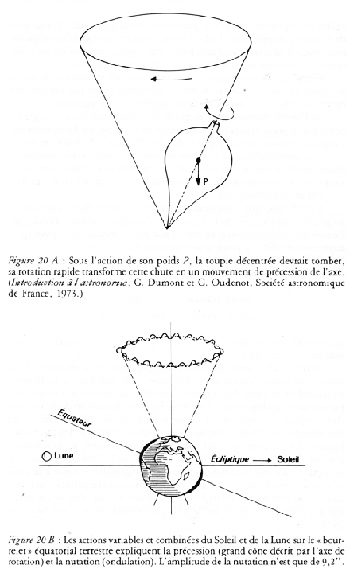 The phenomenon of precession was discovered by Hipparchus of Rhodes (IIth century BC). That of nutation by astronomer James Bradley (1692–1792), the best in Europe according to Newton (we also owe him the discovery of the aberration of light).
The phenomenon of precession was discovered by Hipparchus of Rhodes (IIth century BC). That of nutation by astronomer James Bradley (1692–1792), the best in Europe according to Newton (we also owe him the discovery of the aberration of light).
To leave you with no illusions as to the complexity of things in the sky, you should know that the ecliptic is not perfectly fixed. The gravitational pull of the planets causes this plane to slowly shift. Still due to disruptions “secondary” but apparently not insignificant created by the planets—in addition to other disturbances—the obliquity of the ecliptic also changes slowly and the duration of the precession cycle is not constant…
After the phenomenon and its causes, let us see the consequences. The North celestial pole crosses different constellations in 26,000 years… “polar”. While the Pole Star substantially indicates the direction of North today, in the year 14000 the North Pole will be in the direction of Vega. It is amazing that sensationalist astrologers have not yet thought of using this displacement among the stars to prophesy historical eras. However, obviously, after the year 2000, we will be in the era of Cepheus, and no longer of the Little Dipper nearing completion.
The Signs are actually “phases” characteristics of a cycle, whereas the constellations characterize regions by proposing their landmarks. Is it possible that the troubadours of Einsteinian spacetime don’t understand? We may have the beard and the head in the stars, the viscera remain close to the ground when it comes to settling his family affairs. And we must not forget that astronomy owes its origins to the astrologers-astronomers of Sumer. It must be hard to have an irrational mom when you’re a prophet of the rational… Or else that explains everything.
Now imagine that Pierre was called Vernal-Bélier, about two thousand two hundred years ago, and his suite Paul-Taureau, Jacques-Gémeaux. Pierre, not knowing that he was trotting minutely among the stars, had the annoying idea of giving his name to those that filled his frame. Since then, as his setting has changed, it is said of Pierre that he no longer exists and has never existed. Nobody, it seems, would have the idea of transmitting his name to stars… They are neither our children, nor our works, nor our property… and science has proven that man is logical. Yes. Here is where is the key to this debate worthy of the sophists: who gave the name to the other? The Sign to the constellation, or the constellation to the Sign? In fact, the simple nominal statement of the twelve Signs answers the question. But let us not deprive ourselves of a fuller demonstration.
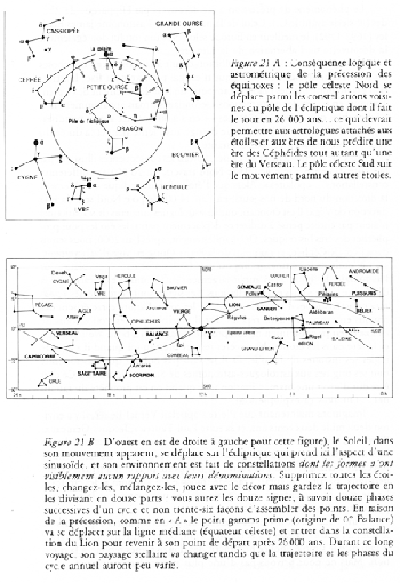 A universal characteristic of physical bodies, from the smallest to the largest, seems to revolve around itself and around another who does the same. And when we are not turning, we depend on at least one body – most often several – which turns.
A universal characteristic of physical bodies, from the smallest to the largest, seems to revolve around itself and around another who does the same. And when we are not turning, we depend on at least one body – most often several – which turns.
Our Mother Earth rotates around its axis in 23 hours 56 minutes 4.1 seconds in mean solar day, and in 365.26… mean solar days around the Sun (sidereal revolution). Its orbit is represented by an ellipse of very low eccentricity. In reality, according to the principle of the sprinkler being sprinkled and of the turned turning, the Sun being itself drawn into a revolution of 200 million years around the center of the galaxy, the planets of its procession describe spirals and not ellipsis.
In this journey of which we are only ephemeral passengers, the Earth moves on a background of stars… a marvelous decor that by convention we have projected onto a sphere of dimensionless radius. This is sometimes called celestial sphere of fixed sphere, the “fixed” pointing to the stars. But the adjective is a bit lost. We dare not use it when we think of the cosmological theories that cause galaxies to flee at fantastic speeds, proportional to their distances, and this since the world was born, 15 to 16 billion years ago, from a scary big Bang that only God the Father may have heard.
Compared to the terrestrial observer, there are galaxies, therefore stars, whose distance implies a flight speed equal to that of light (299,792.6 km/s). Beyond this distance of 1023 km, the universe is no longer visible. These stars on the edge of vertigo only send us images of the past… photos yellowed (or reddened) by the light years that separate us from them. Also, for those that are still leaking, it is not in the condition or shine we see them in today. By now, some of them may be dead? The best known quasi-stellar object (quasar) is moving away at the speed of 270,000 km/s. If, at this rate, an accident occurs now, we would only know it in 18 billion light years. It will be too late! P&Ts don’t go fast in the spacetime of relativity.
Such are, in broad strokes, the logical and astounding theories of astrophysicists experienced in all conceptual audacities… except for what concerns the effects of the planets on the Earth. Pluto, at 4.5 hours of light would be… too far! Our nearest stellar neighbor, the faintly luminous Proxima Centauri, is 4.3 light-years away. This is the time it takes to cover 40,000 billion km at the rounded speed of 300,000 km/s.
Let’s forget the piercing eyes of pure reason for those, a little troubled, of our senses. It is estimated that the stellar system of which the Sun is a part consists of about a hundred billion stars. In the sky of the two hemispheres together, there are, however, only 6,000 stars visible to the naked eye. So that: “The number of stars visible in the sky at any given time hardly exceeds two thousand…” A number that will have to be reduced to a few, next to nothing, to form the ring of ecliptic constellations.
The ecliptic, the path of the Sun among the stars—literally the path where eclipses occur—eliminates an enormous population of stellar landmarks from which its dozen abstract figures are drawn. On what remains of stars, in the solar path, the notion of brilliance operates another reductive selection.
Two great astronomers of antiquity, Hipparchus and Ptolemy, classified stars according to their brightness by dividing them into six groups or magnitudes. For these observers, witnesses of the sky with the naked eye, “the groups were distributed so that the difference in brightness between the members of two neighboring groups was always the same.” By relying on their perceptual faculties, on the discriminating power of the eye, they did not know that their rule was that of a physiological law, Fechner’s law. By modern definitions, the stars of 1D magnitude must be a hundred times brighter than those of 6th greatness. It follows that those of 2th magnitude are about 2.5 times (2.512 times exactly) less brilliant than the first, and so on, following the same coefficient of a magnitude to that which follows it.
It is therefore on a limited sample of stars hierarchized in 6 layers of apparent brilliance that the first astronomers-astrologers identified the path of the Sun. Question: if the stars, in their vision of astrology, were to prevail over the Sun, why would they have privileged only a part (22.5%) of the celestial sphere and the constellations (less than 8%)? Other: does the natural distribution of stellar landmarks justify the arrangements that we know, and are the shapes obtained all related to the names they bear?
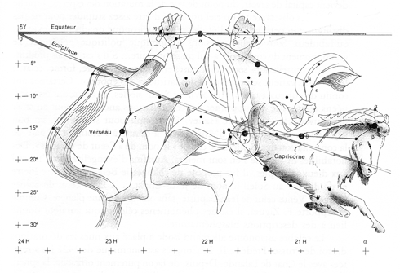 In a “debate” one way on science and astrology, The research did not answer the first question. The author of “debate” alone did not even arise. For the second, the article is illustrated with an illustration which shows, in fact, the arbitrariness of the alignments as well as the strange fantasy of the denominations if they concern the constellations and not something else : Signs, for example…
In a “debate” one way on science and astrology, The research did not answer the first question. The author of “debate” alone did not even arise. For the second, the article is illustrated with an illustration which shows, in fact, the arbitrariness of the alignments as well as the strange fantasy of the denominations if they concern the constellations and not something else : Signs, for example…
Like the anticlericalism of our veterans, anti-astrology does not seem to fortify intellectual rigor. There is no need to go back to Sumerian astrologers to find imaginative authors among astronomers: “In the list (of constellations) composed towards the end of the XVIIth century by Hevelius, an eminent astronomer from Dantzig, there are several recent constellations for the time: the Giraffe, the Fly, the Unicorn, the Dove, the Hunting Dogs, the Fox, the Lizard, the Sextant, the Little Lion, the Lynx, the Shield.” “The French astronomer Lacaille, explorer of the southern sky, completed this list, in 1752, with 14 other constellations: the Sculptor, the Furnace, the Clock, the Reticle, the Chisel, the Painter, the Altar, the Compass, the Pneumatic Machine, the Octant, the Compass, the Telescope, the Microscope, the Table, all constellations of the Southern Hemisphere.”
Lacaille bears a name predestined to the constellations. Nevertheless, we are all appalled… Four thousand years after the magical mentality of a tribe of the Euphrates, there were evolved beings to group stars arbitrarily and give them names. unrelated to their shape, for it goes without saying that you will not see in the southern sky any more table, fly, telescope, painter, than one sees Aquarius and Goat in our hemisphere, otherwise — as it says The research - at the price of this imagination which seems to lack to him to defend the astronomers. Normally, an objective and unimaginative scientist (there are some) should have seen letters and numbers. Why this Sculptor and this Oven? Another astronomer, French but it doesn’t matter in science, shows why: “In 1799, the French astronomer Lalande took the Cat to heaven. To explain this innovation, he says in one of his works: ‘I like cats, I adore them. I hope that after these sixty years of incessant work, I will be forgiven for carrying one of them to heaven.’.”
From this non-primitive testimony with extenuating circumstances, we will deduce the following alternative: either it is the images of the Earth that are taken to heaven (Cat, Sextant, Goat, etc.) or else it is the images of heaven that reproduce on Earth.
Given that the last astronomers who authored the southern denominations obviously named celestial objects from terrestrial objects, if the astrologers of five thousand years ago proceeded differently, it becomes essential to know, from the point of view of mutation of species, when observers of the sky ceased to be so stupid as not to distinguish a small group of stars from any existing or fabulous quadruped. Under what economic, political, genetic pressures, this great moment of consciousness could have happened… if it ever did.
The constellations are capricious in extent, number, shape, brightness… Their names vary according to the countries, the latitudes, the times. Some have known curious avatars. In the XVIIth and XVIIIth centuries, European astronomers “have tried to delete old constellations to create new ones”. The famous Halley, well known for his comet, as a good subject of His Majesty the King of England, gave the main star of the constellation of “hunting dogs” the name of “Heart of Charles”. Notabilities of the Church got involved. For the purpose of evangelization of a sky with multiple gods, it was proposed to change Aries into Apostle Peter and to give the Sun the name of Jesus Christ, the Moon that of Blessed Virgin, Venus that of John the Baptist, without omitting any planet. As reported by F. Ziguel, there are celestial phenomena which would have given rise to blasphemous descriptions.
The famous German astronomer Bode exalted the decorations of the King of Prussia, Frederick II. The 1922 Astronomical Congress rejected them along with Lalande’s Cat. Since then, in a purely official way, the changing sphere of “fixed” has 88 constellations with well-defined boundaries but with a necessarily arbitrary division… although scientific.
Figure 24 concerns the high antiquity assemblages now consecrated “zodiacal constellations”. Apart from the Scorpion whose shape is worth the name, the rest is not obvious. You can always ask your children what they see there, it can be a game, a recreational test. Note that if there are astronomers who wonder how the Ancients could see an Aries in such an abstract figure, Camille Flammarion has perfectly distinguished a horn. Why not?
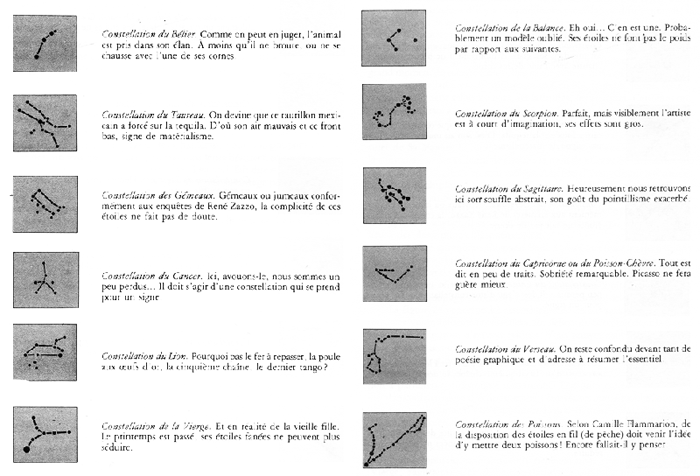
The ecliptic configurations, without being all remarkable, have a pictorial outfit worthy of a non-figurative exhibition. In terms of their supposed influence, they form a heterogeneous suite, irregular in number of stars, in extent (some overlap), in intensity. There are, under this criterion, insignificant constellations (Aries, Cancer), devoid of astrophysical grandeur, others are rich in clusters, nebulae, galaxies (Virgo, Sagittarius). Statistical research conducted by a competent team should bring out the inequalities of such a contrasting field of influence. And even with non-competents, the relief from one constellation to another gives the results the opportunity to reflect its inequalities. However, this is not the case… There is no relationship, in fact, between the abysses and peaks of a stellar zodiac, the distribution of peaks and troughs, and the distribution of psychological traits throughout twelve Signs which signal no anomaly, chasm or Annapurna. However, one cannot dream of harsher and more pure differences.
Such are the documents in the dossier of stellar astrology: inconsistent, arbitrary, subjective, from three centuries before Christ to two centuries after. For its adversaries, there is no other conceivable astrology and its defense becomes impossible, absurd… hence the interest of reducing it to the stars and their mythical designations. But, on the other hand, it is to take the cradle of science and its children, the Chaldeans, for a nursery of weaklings, an opinion not shared by all their heirs, scientific or literary, of this century. Anti-astrology, it is true, makes people say anything.
The constellation file does not plead more for the astrologers who, sensitive to the criticisms of astronomers, adopted the stellar zodiac (with origins varying from one author to another). The least unreasonable argument to support such a challenge to rigor, experience and history, may be that a divine intelligence with provident determinations placed the stars as it should, where it should, so that the beings of its choices, at the right time, give them the right names, accorded to their forms and physico-symbolic properties.
Let’s see if the Signs file saves us from bringing the divine into cooperation.
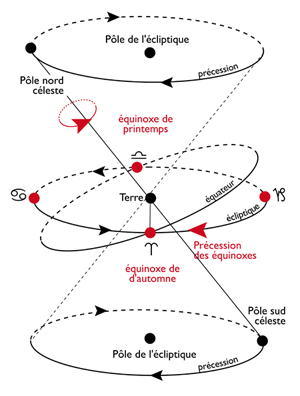 Extensive specialization is detrimental to communication when it does not simply exclude open-mindedness. Astrometers in favor of stars and precession as good means of refuting the Signs could only cast a distracted eye on the publications of their fellow historians. In The Science of the Chaldeans, Marguerite Rutten (honorary assistant curator of the National Museums), quoting Diodorus of Sicily, recalls what were the astrological theories of the Chaldeans on the zodiac: “Among the counselor gods there are twelve chiefs, each of whom presides over a month of the year and over one of the twelve signs of the zodiac. The Sun, the planets and the Moon pass through these Signs.”
Extensive specialization is detrimental to communication when it does not simply exclude open-mindedness. Astrometers in favor of stars and precession as good means of refuting the Signs could only cast a distracted eye on the publications of their fellow historians. In The Science of the Chaldeans, Marguerite Rutten (honorary assistant curator of the National Museums), quoting Diodorus of Sicily, recalls what were the astrological theories of the Chaldeans on the zodiac: “Among the counselor gods there are twelve chiefs, each of whom presides over a month of the year and over one of the twelve signs of the zodiac. The Sun, the planets and the Moon pass through these Signs.”
On the stars: “Outside the zodiacal circle, they determine the position of 24 stars, half of which are in the north and the other half in the south; they call them ‘judges of the Universe’: the visible stars are assigned to living beings, the invisible stars to the dead.” And again the zodiac according to Marguerite Rutten: “The Babylonians, having recognized very anciently that the planets, the Sun and the Moon, follow a course which is substantially in the same celestial region, realized the ‘zodiac’, or plane of the ecliptic which they divided into 12 ‘bèrou’ (sectors of 30°). They had to, to determine the trajectory of the Sun, establish points, taken from among the brightest stars, which formed the 12 signs of the zodiac.”
Unless you dispute the translations, the translators, the mathematical sense of the Babylonians, their spirit of observation, and retain only their magical practices, it is quite clear that, without knowing the phenomenon of precession, they did not take the months for Signs, the Signs for stars and that these have above all served as landmarks for tracing the path of the Sun. Moreover, because of their religious sense as well as their attachment to the magic of names, it is unthinkable that the Sumerians could designate anything by anything. At that time, before seeing a table or a cat in the sky like the astronomers of the XVIIIth century, it had to be done several and several times. Only 20th century technocratsth century can allow themselves to be marginalized in a homogeneous ethnic group their fantasies anti-astrological. Their methods of pathological surgeons also extend to the brains of creators and thinkers who have had some weakness for astrology.
The Babylonians perfectly distinguished day and night… although they take stars for a goat. The constellations come from observations made at night, in accordance with human vision… either before the Sun rises, or after it has set, which makes it possible to situate it in its setting by the stars which follow and precede it. By day, its brilliance, the diffusion of its light in our atmosphere, hides the background. There is only him. In contrast to the constellations that show up at night, the Signs relate to what shows up during the day: men, social activities, the seasons, the months, animals, things and people, the Sun in person. In short, the human, social, cosmic march of time and its rhythms.
While it is difficult to discern a crayfish (another or original name for Cancer) in the unoriginal arrangement of stars, at the summer solstice (June 21–22) any unbeliever in our hemisphere will find that the day, having ceased to grow, will recede in its duration as a crayfish recedes in its space. Another incredulous who would lose his reason to look for a balance in the constellation of this name will be able to admit that the symbol of balance is appropriate, not for the stars of this region, but for the month of the year when the length of the day and the night equalize. In his tetrabible, Claudius Ptolemy who had compiled Hipparchus, the discoverer of precession, explains the denominations of the Signs by solar phenomena (tropical year) and not by stellar arrangements. The following text from IIth century AD shows without possible dispute that post-Chaldean astrologers, even using fixed stars, linked the zodiac to the seasonal phases:
“There are indeed two tropic signs, on the one hand the first interval of thirty degrees since the summer solstice, that is the Sign of Cancer, on the other, the first since the winter solstice, that is Capricorn. These Signs have received their name from what is going on in them. Indeed the Sun, when it has entered these Signs, recoils backwards, turning its course in an opposite latitude, causing summer in Cancer, and in Capricorn, winter.” “There are two more equinoctial signs, Aries in spring and Libra in autumn, which also took their name from what happens in them, for when the Sun is at the beginning of these Signs, the spaces of day and of the night are equal for all the Earth.”
Closer to us in time, in the XVIIIth century, an astronomer unsuspected of pro-astrological feelings, François Arago, expresses in his popular astronomy his understanding of the differences: “We must therefore take care, to avoid any confusion, to clearly distinguish the word constellation from the word sign. The constellations are figures of men or animals, drawn in the zodiac, and having, as we have already said, no relation to the disposition of the stars which they contain. The Signs are divisions of 30 degrees each, without any necessary connection with the constellations whose names they bear. By virtue of the precession of the equinoxes the signs no longer coincide with the constellations.”
Ptolemy recognizes the difference by attributing to the Signs a nature which they take from the Sun on a month-to-month basis. Arago affirms the difference by reducing the Signs to a geometric division. On this end of the century, astronomers declare, on their charcoal faith, that there have never been any Signs… Where is the difference?
Ancient or modern, astrologer or astronomer, is it really possible to deny the solar source of zodiacal symbols ? Yes, if, the spirit of contradiction helping, we ask all the Signs to be as explicit as Libra and Crayfish. However, these are symbols and, by definition, symbols do not directly express what they designate, apart from the fact that they can designate several things with comparable functions or structures. Pisces-Goat is best understood by the winter solstice than by a meager scattering of stars, but the analogy must be used. So, in our hemisphere, this monster is only a Sun at the onset of winter: fish from behind because it has hit rock bottom during its descent below the plane of the celestial equator, goat in front because he will reconquer the lost heights. The logic of this interpretation does not exclude others. In his Uranography, L.B. Francoeur thus relates Pluche’s explanatory system. Some of its elements (the Lion in heat, the Virgin in harvest…) still have credit in contemporary linear symbolist astro-psychology:
“According to Pluche, Aries and Taurus began spring in origin; and at this time sheep and cows give birth. The following month, the goats do the same, and Gemini was also represented by two goats, or by two lovers, a symbol of fertility. Cancer announces the summer solstice by retrograding to the descending signs. The Lion responds to the heat and the Virgin to the harvest, of which her ear is the symbol. Libra designates the equality of days and nights at the autumnal equinox; Scorpio, the diseases frequent in this season; Sagittarius, common hunting pleasures in November. Capricorn announces that the Sun is rising towards the higher signs. Aquarius is the rainy season and Pisces the fishing season.”
By evoking precession and by attributing, wrongly, the invention of the zodiac to the Egyptians, Francoeur challenges Pluche to prefer the explanation of Charles-François Dupuis, based on the various incidences of the fluctuations of the Nile. For Francœur, who was not just anyone (professor at the Faculty of Sciences of Paris), the seasonal origin of the names of Signs is not in doubt, and it is Egyptian, it is clear as the waters of the Nile: “The zodiac is an Egyptian invention; it represents too faithfully the series of annual phenomena peculiar to the climate of Egypt for there to remain the slightest doubt in this respect: chance does not give birth to these prodigious gatherings of facts which all conspire towards the same end. The twelve principal acts of nature have received as emblems the twelve celestial signs which the sun traverses annually. This is what it is impossible to deny.”
The documentation service of The research should definitely get some additional works for authors worried about the excessive imagination of the Chaldeans. Jean Claude Pecker could have learned there that an eminent colleague of a recent century would undeniably relate the Signs to the annual course of the Sun by linking the acts of nature to the stellar emblems. The result, according to Dupuis, is a curious decoding of the monstrous Fish-Goat: “Dupuis admits that, in remote times, the Sun was in the constellation of Capricorn at the time of the summer solstice; the star then reaching its highest limit, was compared to goats who like the heights. Capricorn is indeed represented in the attitude of rest which is appropriate for the solstice; its tail of Pisces relates to the flood which is about to begin (around the middle of July).”
A scientist, from the same academy as Pecker, admits headlong the explanation of another member of his corporation who, to justify his thesis, shifts the signs by 180° so that the Egyptians accord their daily activities to the emblems they see the night. Who dreams in this world? Not J.-C. Pecker since it is enough for him to forgive himself for mistakes in the name of “scientific revolutions” Who “consider the abandoned theories as necessary steps, as reflections of first approximation… This true scientific activity, with its remorse, its returns, its alterations, and all the same its effective coherence, conceals too many splendours for one to have need the philosophically contradictory ersatz of magic and astrology…” Because, let us know, the science with retouches is not contradictory and: “…the world is beautiful, just as it is. Just look at it and seek to understand it, without sterile dreams and without irrational fears, and marvel…” Like Francoeur.
After Ptolémée, Pluche, Dupuis, Francoeur, Arago, all failed in the baccalaureate of “Don’t touch my edits” or “Before me the deluge”, a modern attempt to explain the denominations of Signs deserves to be mentioned, that of René Alleau which appears in the article “Astrology” of the Encyclopedia Universalis. First, on the origins of the zodiac, René Alleau disputes the sources of the historian Diodore of Sicily. The Chaldeans he evokes, he says, are “already mythical, and the charlatans who replace them only bear their name”. We do not know what Marguerite Rutten thinks of it… Then, using inventories of celestial asterisms, he reconstructs “the first known zodiacal structure” with the keys — caught in the asterisms — of its “true historical significance”. It is obviously impossible, in this overview of theses and antitheses, to reproduce the entire text of René Alleau. We learn new things, very interesting or the stellar denominations remain linked to terrestrial objects.
Still according to this author, the babylonian zodiac cannot go back more than 2,160 years before the Christian era, otherwise it would be necessary to make a complete turn of precession and go back to 25,920 years before J.-C. Finally, for René Alleau, “the concordance of the first date with the evolution of the divinatory techniques practiced on animals at the time of the first dynasty of Babylon makes it possible to understand that… the zodiacal topology was deduced from a divinatory anatomical topology, projected on ‘celestial animals’, and not of astronomical observation”.
While admiring the original research of René Alleau, we admit that we do not quite understand who these “celestial animals”. The clearest part of his thought, which we translate freely here, seems to be that the Babylonians, trained to read the will of the gods by examining animal entrails (haruspices), looked upon the starry sky as composed of symbolic animals. In this case, it is still a question of extolling what one carries in the heart, in one’s mores, habits and concerns, in this case divinatory.
Apparently somewhat dissatisfied — there is reason — by “the artificial and conventional character of the Babylonian zodiacal topology”, so from this reduction of the sky to contingent divinatory practices, René Alleau finally finds that the zodiac and its division into twelve parts fall within the archetypes of the circle and numbers. Basically, there is no longer any need to question history. There are eternal structures that are expressed differently through the prism of eras and ethnic groups… and the circle remains a circle above the world of men, far from their imperfections but omnipresent in the collective unconscious. Which makes R. Alleau say: “More durable than the Tower of Babel, the zodiac has withstood all the accidents of History. He owes it less to his marvelous images than to the secret truth they hide and which Pythagoras alone seems to have discovered and carefully hidden: those of the harmonic structures of space and time revealed by the geometry of the circle. This is also the great scientific principle that astrological divination unconsciously exploits…”
While completing his quest for a metaphysical apotheosis (the structure of the circle), Alleau nonetheless commits the clumsiness of taking, like the majority of contemporary scientists, the Babylonians for minds relatively a little more backward than those of our time… since they are years back in our accounting. However, would we not be closer to the collective unconscious and, consequently, to structures, by being less reasoning than in the 20th century?th century? In short, uneducated anthropoids (or in the process of culture) must theoretically communicate with the universal unconscious better than human beings. homo sapiens imbued with neo-rationality. The oldest of the zodiacs would be the purest, the closest to authenticity, a bit like it was once appropriate to judge the savage “close to nature” despite his incivility.
Let’s leave these debates there for a moment. It emerges from the dossier of the Signs that their symbolism lends itself to multiple readings. But it appears that all the exegeses on their denominations deliver a logic (internal or historical) only by taking their sources in the tropical year organizing human activities at all conceivable levels. To make the zodiac ridiculous, one must on the one hand depreciate these activities when they date back to bygone millennia, believe or pretend to believe that the Sumerians — somewhere our ancestors — saw graffiti in the stars.
Text taken from Universal Astrology, ed. Albin Michel 1986.
▶ Zodiaque des Signes & constellations : vidéos
▶ Your zodiac Sign
▶ Signs and seasons
▶ Planetary trios in Signs
▶ The zodiac and the precession of the equinoxes
▶ Le monde selon Claude Ptolémée, astronome-astrologue et phare d’Alexandrie
▶ The astronomical reality of the zodiac
▶ The human reflexology zodiac
▶ Autour du zodiaque : de l’eau dans un Signe de Feu ?
▶ Zodiaque et sphère locale
▶ Mythologie du zodiaque
▶ Zodiaque et formes de l’inhibition
▶ Change-t-on de caractère en changeant de Signe solaire ?
▶ Énergie-Espace-Temps-Structure et zodiaque
▶ Genèse du zodiaque conditionaliste
▶ L’horloge photopériodique du genou
▶ Signe solaire et Signe Ascendant
▶ Astrologie, adaptation & inadaptation
▶ Les rythmes du zodiaque
▶ Cosmographie simplifiée du système solaire
▶ Thème de domitude et hiérarchisation planétaire
▶ Effets et contre-effets des images et représentations sur les faits et les idées
▶ Le taijitu dans le système solaire
▶ Zodiaque, planètes et typologie jungienne
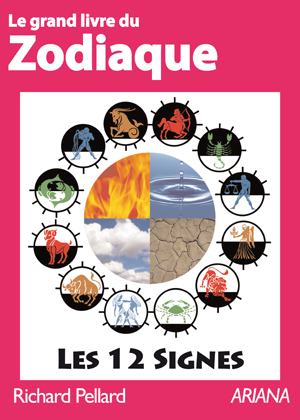
Le grand livre du zodiaque
par
180 pages. Illustrations en couleur.
Ce livre présente et explique les trois zodiaques : celui du décor des constellations, celui de l’astrologie traditionnelle basé sur les Quatre Éléments symboliques (Feu, Terre, Air & Eau) et celui de l’astrologie naturelle basé sur les phénomènes astronomiques objectifs.
Téléchargez-le dès maintenant dans notre boutique